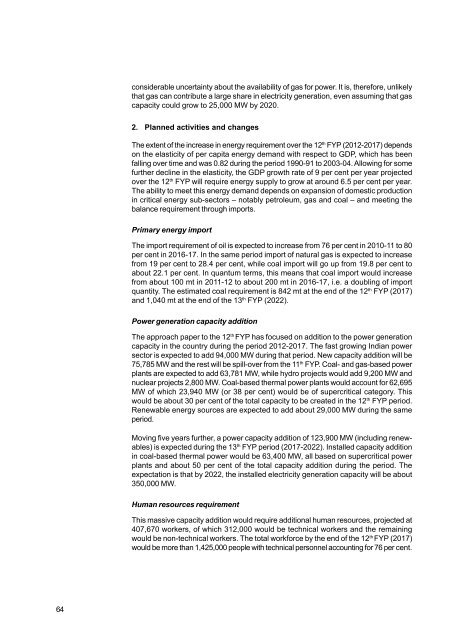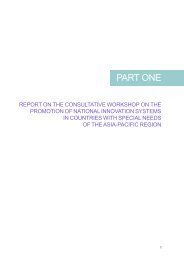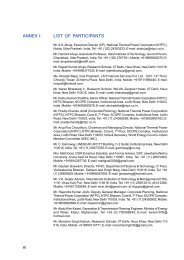Download Complete PDF - apctt
Download Complete PDF - apctt
Download Complete PDF - apctt
- No tags were found...
You also want an ePaper? Increase the reach of your titles
YUMPU automatically turns print PDFs into web optimized ePapers that Google loves.
considerable uncertainty about the availability of gas for power. It is, therefore, unlikelythat gas can contribute a large share in electricity generation, even assuming that gascapacity could grow to 25,000 MW by 2020.2. Planned activities and changesThe extent of the increase in energy requirement over the 12 th FYP (2012-2017) dependson the elasticity of per capita energy demand with respect to GDP, which has beenfalling over time and was 0.82 during the period 1990-91 to 2003-04. Allowing for somefurther decline in the elasticity, the GDP growth rate of 9 per cent per year projectedover the 12 th FYP will require energy supply to grow at around 6.5 per cent per year.The ability to meet this energy demand depends on expansion of domestic productionin critical energy sub-sectors – notably petroleum, gas and coal – and meeting thebalance requirement through imports.Primary energy importThe import requirement of oil is expected to increase from 76 per cent in 2010-11 to 80per cent in 2016-17. In the same period import of natural gas is expected to increasefrom 19 per cent to 28.4 per cent, while coal import will go up from 19.8 per cent toabout 22.1 per cent. In quantum terms, this means that coal import would increasefrom about 100 mt in 2011-12 to about 200 mt in 2016-17, i.e. a doubling of importquantity. The estimated coal requirement is 842 mt at the end of the 12 th FYP (2017)and 1,040 mt at the end of the 13 th FYP (2022).Power generation capacity additionThe approach paper to the 12 th FYP has focused on addition to the power generationcapacity in the country during the period 2012-2017. The fast growing Indian powersector is expected to add 94,000 MW during that period. New capacity addition will be75,785 MW and the rest will be spill-over from the 11 th FYP. Coal- and gas-based powerplants are expected to add 63,781 MW, while hydro projects would add 9,200 MW andnuclear projects 2,800 MW. Coal-based thermal power plants would account for 62,695MW of which 23,940 MW (or 38 per cent) would be of supercritical category. Thiswould be about 30 per cent of the total capacity to be created in the 12 th FYP period.Renewable energy sources are expected to add about 29,000 MW during the sameperiod.Moving five years further, a power capacity addition of 123,900 MW (including renewables)is expected during the 13 th FYP period (2017-2022). Installed capacity additionin coal-based thermal power would be 63,400 MW, all based on supercritical powerplants and about 50 per cent of the total capacity addition during the period. Theexpectation is that by 2022, the installed electricity generation capacity will be about350,000 MW.Human resources requirementThis massive capacity addition would require additional human resources, projected at407,670 workers, of which 312,000 would be technical workers and the remainingwould be non-technical workers. The total workforce by the end of the 12 th FYP (2017)would be more than 1,425,000 people with technical personnel accounting for 76 per cent.64







